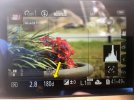It just depends on how fast objects are moving and how close they are to the camera. Shutter angle also portrays a certain subconscious feeling that can’t be seen In a comparison.
180 degrees is just a standard amount of motion blur. If an object is moving really fast you’ll need more motion blur ie longer shutter speed. There is nothing moving quickly or close to the camera in your video so you can get away with a faster shutter speed without odd artifacts. Do one of a car driving quickly through the frame, a runner, a bicyclist, fly close to the ground and then let me know what you see. 180 degree rule is just a good neutral starting point. It’s a “rule of thumb” nobody ever said it was a law.
Also rolling shutter isn’t affected by shutter speed. Two different concepts. Rolling shutter is constant and doesn’t change.
The reason for this is because there is time between when one frame has finished being exposed and the next frame starts being exposed. This hasn’t changed with modern high tech cameras or 4k so it’s just as applicable not as it was 100 years ago.
Here are two clips to which do a pretty good job of showing the two extremes. Notice the runners arms as they get closer to the camera. Notice that it doesn’t matter when they are far away.
(Edit: I guess you’ll have to click the button to watch the videos. It won’t let me embed them)
45 degree shutter
360 degree shutter











